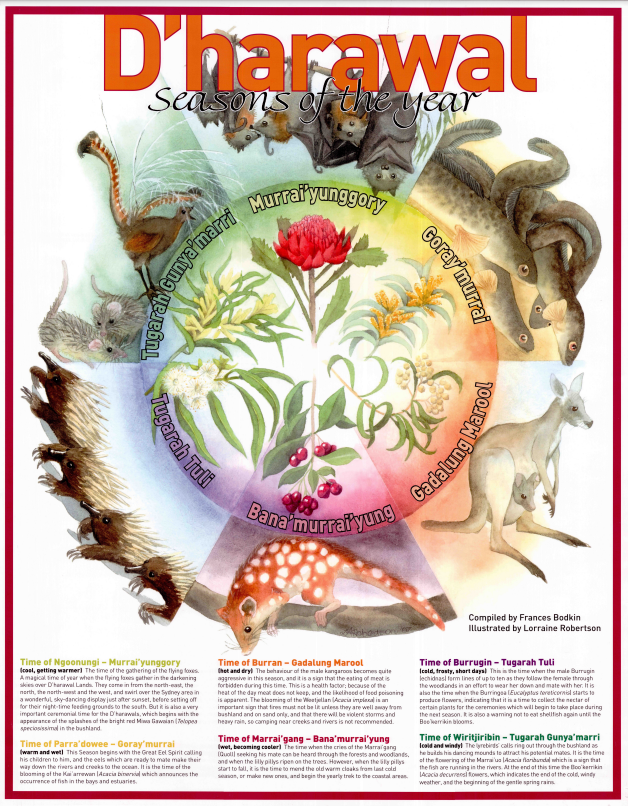Understanding the patterns of the landscape in which we live and grow our food is crucial. In the Illawarra, we are on D’harawal land, bounded by Port Jackson to the north, the Southern Highlands to the west and to Jervis Bay to the south.
The Wodi-Wodi people of the D’harawal Nation are Traditional Custodians of the land. We acknowledge that they have lived sustainably in this landscape for thousands of years and understand the complex and interconnected cycles of weather, plants and animals.
To better understand the cycles of the D’harawal landscape, we recently connected with Traditional Knowledge-holder Dr Frances Bodkin. Dr Bodkin generously met with us for a day and shared a small slice of her extensive knowledge.
As detailed in Frances Bodkin and Lorraine Robertson’s book D’harawal Climate and Natural Resources, the cycles of the D’harawal landscape operate at many scales:
- the daily cycle (gamaruwamumu);
- the annual cycle of six seasons per year; and
- the mudong cycle every 11-12 years.

‘The yearly calendar does not rely upon dates in months and weeks, or even an understanding of the solstices, but on key events that occur in the environment. These events involve specific plant flowerings and fruitings, and noticeable quirks of animal behaviour that occur only at certain times of the year. The calendar is not set rigidly in time, but responds to the triggers of the environment, a response to the Land of the D’harawal Peoples as they moved through the environment, observing the signs of these changes.’
Frances Bodkin, D’harawal Climate and Natural Resources
The six seasons within the annual cycle are:
- The Time of Burrugin – Tugarah Tuli
Cold, frosty, short days (June / July)
This is the time when the male Burrugin (echidnas) form lines of up to ten as they follow the female through the woodlands in an effort to wear her down and mate with her. It is also the time when the Burringoa (Eucalyptus tereticornis) starts to produce flowers, indicating that it is a time to collect the nectar of certain plants for the ceremonies which will begin to take place during the next season. It is also a warning not to eat shellfish again until the Boo’kerrikin blooms.
- The Time of Wiritjiribin – Tugarah Gunya’marri
Cold and windy (July / August)
The Wiritjiribin (lyrebird) calls ring out through the bushland as he builds his dancing mounds to attract his potential mates. It is the time of the flowering of the Marrai’uo (Acacia floribunda) which is a sign that the fish are running in the rivers. At the end of this time the Boo’kerrikin (Acacia decurrens) flowers, which indicates the end of the cold, windy weather, and the beginning of the gentle spring rains.
* More on this season in our August newsletter – sign up below
- The Time of Ngoonungi – Murrai’yunggory
Cool, getting warmer (September / October)
The cold winds have now gone, and the days are starting to get warmer. The buds of the Waratah swell and redden, and the Ngoonungi (flying foxes) gather in vast numbers over D’harawal Lands as the sun sinks below the horizon and dusk falls. Gentle rains fall during this time, and the flowers bloom heavy with nectar. It is a time for ceremony, and the clans gather to celebrate a time of plenty.
* More on this season in our October newsletter – sign up below
- The Time of Parra’dowee – Gooray’murrai
Warm and wet (November / December)
The time of the Parra’dowee (eel) signifies the time to prepare for the very hot weather which will, within the next two moons, scorch the land and the people. This is the time when it is unwise to camp near rivers; the weather is getting hotter and storms with heavy rain more frequent. The golden yellow flowers of the Kai’arrewan (Acacia binervia) indicate the beginning of the season, giving plenty of warning of the storms to come. In massive numbers the freshwater eels begin their long journey down the rivers and creeks and out to sea where they will mate and die.
- The Time of Burran – Gadalung Marool
Hot and dry (January / February)
The staple diet during the time of Burran (the kangaroo) was fruit, seeds, and the roots and tubers of those plants which had finished flowering. It was also usually the hottest time of the year, and a time when the people did not wander far from their water source. This time of year is signified by the blooming of the Weetjellan (Acacia implexa) and indicates that the people were forbidden to eat meat or fish during this time.
- The Time of Marraigang – Bana’marrai’yung
Wet, becoming cooler (March / April / May)
The time of the year when the cries of the Marrai’gang (Quoll) seeking his mate can be heard through the forests and woodlands. The Lillipilli ripens and food is plentiful, however, when the fruit begins to fall from the trees it is a sign that it is time to start moving from the highlands and plains down to the coastal areas. It is also the time to start mending cloaks or making new ones in preparation for the coming cold weather.
Download a PDF of the D’harawal Seasonal Calendar poster here.
We acknowledge and thank Dr Frances Bodkin and illustrator Lorraine Robertson for allowing us to share their work in this story. If you are interested in learning more, we recommend visiting the website D’harawal Stories and ordering the two books: D’harawal Dreaming Stories and D’harawal Climate and Natural Resources, both compiled by Frances Bodkin and illustrated by Lorraine Robertson and published by Envirobook.



